Eff ects of monsoon onset vortex on heat budget in the mixed layer of the Bay of Bengal*
XU Kang , LIU Boqi , LIU Yu , WANG Weiqiang , HE Zhuoqi
1 State Key Laboratory of Tropical Oceanography, South China Sea Institute of Oceanology, Chinese Academy of Sciences, Guangzhou 510301, China
2 Southern Marine Science and Engineering Guangdong Laboratory (Guangzhou), Guangzhou 511458, China
3 Innovation Academy of South China Sea Ecology and Environmental Engineering, Chinese Academy of Sciences, Guangzhou 510301, China
4 State Key Laboratory of Severe Weather and Institute of Climate System, Chinese Academy of Meteorological Sciences, Beijing 100081, China
5 Institute of Deep-sea Science and Engineering, Chinese Academy of Sciences, Sanya 572000, China
6 University of Chinese Academy of Sciences, Beijing 100049, China
7 Laboratory for Regional Oceanography and Numerical Modeling, Qingdao National Laboratory for Marine Science and Technology, Qingdao 266071, China
8 State Key Laboratory of Numerical Modeling for Atmospheric Sciences and Geophysical Fluid Dynamics, Institute of Atmospheric Physics, Chinese Academy of Sciences, Beijing 100029, China
Abstract We investigated the eff ects of monsoon onset vortex (MOV) on the mixed layer heat budget in the Bay of Bengal (BOB) in spring 2003 using the reanalysis datasets. The results suggest that the solar radiation fl ux penetrating the mixed layer and the existence of barrier layer are both able to modulate the eff ects of MOV on the evolution of sea surface temperature (SST) in the BOB. Prior to the formation of BOB MOV, the local SST raised quickly due to mass of solar radiation reaching the sea surface under the clear-sky condition. Meanwhile, since the mixed layer was shallow before the onset of the Asian summer monsoon (ASM), some solar radiation fl ux could penetrate to directly heat the deeper water, which partly off set the warming eff ect of shortwave radiation. On the other hand, the in-situ SST started to cool due to the upwelling of cold water when the MOV generated over the BOB, along with the rapidly increased surface wind speed and its resultant deeper mixed layer. As the MOV developed and moved northward, the SST tended to decrease remarkably because of the strong upward surface latent heat fl ux over the BOB ascribed to the wind-evaporation mechanism. However, the MOV-related precipitation brought more fresh water into the upper ocean to produce a thicker barrier layer, whose thermal barrier eff ect damped the cooling eff ect of entrainment upwelling on the decrease tendency of the BOB SST. In other words, the thermal barrier eff ect could slow down the decreasing trend of the BOB SST even after the onset of ASM, which facilitated the further enhancement of the MOV.
Keyword: monsoon onset vortex (MOV); Bay of Bengal; air-sea interaction; mixed layer depth; barrier layer thickness; heat budget analysis
1 INTRODUCTION
The Asian summer monsoon (ASM) is one of the most complicated components of the Earth’s climate system (Wang et al., 2001; He et al., 2006, 2007). It not only directly aff ects the social activities and economy in Asia with the largest population in the world but also infl uences other area via its remote eff ects (Gadgil and Kumar, 2006; Trenberth et al., 2006; He et al., 2007; Wang et al., 2018). The onset process of the ASM indicates the beginning of summer monsoon. Previous studies have proposed that the ASM fi rstly establishes over the southeastern Bay of Bengal (BOB), then over the South China Sea (SCS), and fi nally over India (Wu and Zhang, 1998; Wang and LinHo, 2002; Mao and Wu, 2007; Liu et al., 2015). As the beginning of the ASM onset, many studies have paid attention to the onset process of the BOB summer monsoon (BOBSM). For instance, Mao and Wu (2007) pointed out that both the winter-tosummer seasonal transition and the ASM onset started with the northward tilting of the subtropical ridge surface towards the warmer region, presenting the emergence of positive meridional temperature gradient in the mid-upper-troposphere of the BOB. A type of low-level vortex, which always existed over the BOB in early May during the BOBSM onset (Lau et al., 1998; Liu et al., 2002), is known as the monsoon onset vortex (MOV) in the atmosphere. Vinayachandran et al. (2007) showed the detailed structure of the MOV and its association with the sea surface temperature (SST) in the BOB. They found out that the warmest SST occurred in the eastern BOB before the BOBSM onset. Mao and Wu (2011) attributed the generation of typhoon Nargis over the BOB in spring 2008 to the atmospheric barotropic instability and diabatic heating over the BOB. The BOBSM built up with the northward movement of the developed MOV (Liu et al., 2013, 2015). Case studies suggested that the formation and development of the BOB MOV were associated with the short-term spring warm pool in the BOB via the local air-sea interaction (Wu et al., 2011, 2012). In particular, the atmospheric available potential energy is generated over the BOB and then converted to the kinetic energy, thereby resulting in the formation of a MOV (Wu et al., 2012).
The evolution of the BOB MOV is closely associated with the variation of the local oceanic mixed layer, which refl ects the intense turbulent mixing in the upper ocean and directly interacts with atmosphere. Wu et al. (2011, 2012) pointed out that the shallow ocean mixed layer facilitated the quickly warming of the BOB SST, while the mixed layer depth (MLD) increased rapidly with the development of the MOV to cool the local SST by the upwelling of cold water in the deeper layers. Therefore, the variation of local oceanic MLD is vital to the formation and development of the BOB MOV. Actually, the transports of mass, momentum, and energy in the mixed layer provide most of the ocean kinetic energy (de Boyer Montégut et al., 2004). On the other hand, the wind forcing also plays an important role in the oceanic energy cycle and oceanic circulation, especially the heat budget of surface mixed layer (Shi et al., 2017, 2018). Previous studies emphasized the key roles of the MLD in the distributions of the net surface heat fl ux (Chen et al., 1994), the near-surface acoustic propagation (Sutton et al., 1993) and even the marine ecosystems (Prasanna Kumar and Narvekar, 2005). When the spring mixed layer in the BOB is shallow, the solar radiation with a wavelength less than 700 nm is able to penetrate the mixed layer, and then directly warmed the seawater below the mixed layer. Based on the Buoy data, Sengupta et al. (2002) demonstrated that the solar radiation fl ux penetrating the BOB mixed layer in spring could reach about 45 W/m2. Its magnitude and variations greatly aff ected the upper ocean dynamics and thermodynamics, as well as the marine ecological process (Kraus and Turner, 1967; Lewis et al., 1990; Ohlmann et al., 1996). The eff ects of the BOB MOV on the oceanic mixed layer resemble those of the tropical cyclone, which have been examined since the 1960s. In the mid-1960s, the scientists started to use one-dimensional oceanic mixed layer model to examine the variation of upper oceanic layers (Kraus and Turner, 1967). Subsequently, the two- and threedimensional ocean models were developed to investigate the oceanic responses to the tropical hurricanes (Elsberry et al., 1976; Price, 1981). It was found that the tropical cyclones brought the cold water in deeper layers into the mixed layer to decrease SST by the entrainment upwelling processes (Sakaida et al., 1998). The colder SST could change the intensity and structure of tropical cyclones as a feedback (Behera et al., 1998; McPhaden et al., 2009; Zeng and Chen, 2011). In addition, the MOV-induced precipitation increased the input of freshwater into the BOB, where the upper-oceanic salinity gradient and the pycnocline was changed (Lukas and Lindstrom, 1991; Sprintall and Tomczak, 1992). Thus, the thermocline is deeper than the pycnocline to form the barrier layer (Sprintall and Tomczak, 1992). The barrier layer thickness (BLT) was defi ned as the diff erence between the depth of the thermocline and the pycnocline. Acting as a thermal barrier for the vertical heat exchange, the barrier layer could prevent the eff ective heat exchange between the thermocline and the pycnocline (Godfrey and Lindstrom, 1989). It partly off set the cooling eff ects of the entrainment upwelling to modulate the oceanic heat budget in the mixed layer, the SST and the air-sea heat fl ux (Swenson and Hansen, 1999).
Although the eff ects of spring warm pool in the BOB on the MOV and ASM onset have been shown in Wu et al. (2012), the feedback of BOB MOV on the evolution of local SST with the barrier layer is unclear. In climatology, the warming of the spring SST over the BOB is primarily controlled by the air-sea net heat fl ux while the role of oceanic process is limited (Santoso et al., 2010). However, the infl uences of spring tropical cyclone on the SST in the BOB should be quite diff erent. Since the BOB MOV lives long after its generation in spring 2003, it implicates a potential positive feedback between MOV and SST in this year. Hence, the present study aimed to revisit how the BOB MOV infl uences the heat budget in the upper ocean with a barrier layer, and to show interaction between MOV and SST especially after the ASM onset.
2 DATA AND METHOD
2.1 Data
The pentad oceanic reanalysis datasets, including the oceanic temperature, salinity, and threedimensional current velocities, were investigated using the US National Centers for Environmental Prediction (NCEP) Global Ocean Data Assimilation System (GODAS; Behringer and Xue, 2004; Saha et al., 2006). This dataset had constant zonal resolution of 1° and a variable meridional grid of enhanced to 1/3° within 10° of the equator, accompanied by 40 levels with a 10-m resolution in the upper 200 m. The daily SST was obtained from the National Oceanic and Atmospheric Administration (NOAA) optimum interpolation SST, version 2 (OISSTv2; Reynolds et al., 2002), with a high horizontal resolution of 0.25°×0.25°. The daily atmospheric reanalysis datasets, including three-dimensional wind, 10-m wind, net surface shortwave radiation, net surface longwave radiation, surface latent heat fl ux, and surface sensible heat fl ux, were investigated using the National Centers for Environmental Prediction-Department of Energy (NCEP-DOE) Reanalysis 2 (Kanamitsu et al., 2002). Their surface variables are stored on a global T62 Gaussian grid, and the upperair variables are available at the 2.5°×2.5° horizontal resolution and extend from 1 000 to 10 hPa with 17 vertical pressure levels. The pentad precipitation fi elds were taken from the Climate Prediction Center (CPC) Merged Analysis of Precipitation (CMAP) with a resolution of 2.5°×2.5° (Xie and Arkin, 1997). All the daily variables were converted to the pentadmean values similar as the temporal resolution of the GODAS and CMAP products. The climatology of each element was defi ned by its arithmetic average from 1980 to 2010.
2.2 Methodology
The oceanic isothermal layer (IL) and mixed layer (ML) are defi ned as follows. The ML is an upper turbulent layer in the ocean, which was defi ned as the quasi-homogeneous surface density layer (Du et al., 2005). Kara et al. (2000a, b) have proposed the optimal defi nitions for determining the IL depth (ILD) from temperature profi les and the MLD from density profi les, which could be applied in all regions of the world's oceans. The ILD (MLD) was identifi ed as the base depth of an isothermal (isopycnal) layer, where the sea temperature (density) changed by a fi xed amount of ΔT( Δσt=σt(T+ ΔT,S,P)–σt(T,S,P), whereTandSdenote the sea temperature and salinity, respectively, andP=0 from the temperature (density) at a reference of 10-m depth. For the MLD, Kara et al. (2000a) compared diff erent criteria and suggested that ΔT=0.8°C is a proper criterion. Because of the inconsistent distributions of sea temperature and salinity, the IL was usually deeper than the ML. Their diff erence was generally described as a barrier layer (BL; Lukas and Lindstrom, 1991; Sprintall and Tomczak, 1992; You, 1995), and the depth from the bottom of the MLD to the top of the thermocline was defi ned as the barrier layer thickness (BLT).
The heat budget in the mixed layer was expressed by the following equation (Qiu, 2000; Qu, 2003; Du et al., 2005):

in whichTmindicates the mean seawater temperature in the mixed layer,hmis the MLD,ρandCpare the reference density and specifi c heat of seawater, respectively.Tdis the temperature at 5-m below MLD to represent the cold water entrained in the ML. Theindicates the zonal and meridional velocities averaged in the MLD. Each term in Eq.1 is averaged in the mixed layer. The term in the left-hand side of Eq.1 is for the temperature tendency, while the four terms in the right-hand side represented the eff ect of surface thermal forcing, horizontal advection, vertical entrainment, and the residual term (R), respectively.
In Eq.1,Q0denotes the net surface heat fl ux, which was the sum of the net downward shortwave radiation (Qsw), net downward surface longwave radiation, and surface latent and sensible heat fl uxes. Here a positive value indicates the downward heat fl ux into the ocean. The penetration of solar radiation below the ML (qd) is estimated as (Pacanowski and Griffi es, 1999)
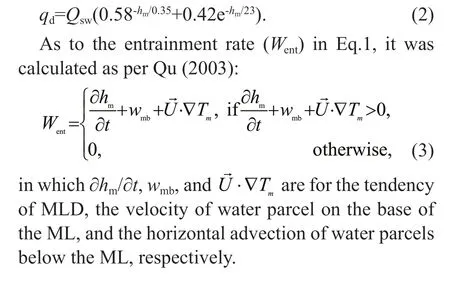
3 RESULT AND DISCUSSION
3.1 Onset process of the BOBSM in 2003
The MOV is actually a tropical cyclone during the BOB summer monsoon onset. These tropical cyclones show diff erent genesis and complicated tracks, and their corresponding lifetimes are inconsistent. In 2003, the BOBSM built up on May 12. Before the BOBSM onset, the MOV formed in the southeastern BOB on May 8. It then developed and moved northwestward. The MOV peaked on May 13 with the minimum of sea level pressure existing on the BOB. Subsequently, the MOV gradually weakened and moved northeastward. It fi nally faded away over the western Burma on May 19. Therefore, the 2003 case is one of the most classical examples for investigating the eff ects of MOV on the BOB mixed layer heat budget because of its typical track and lifetime. The lifespan of the BOB MOV can be verifi ed by the pentad evolution of the low-level wind and precipitation in spring 2003 (Fig.1). In Pentad 24 (April 26–30), the subtropical high was continuously extending from the Arabian sea to the northern SCS, presenting two centers of the low-level anticyclone over the northern Indian peninsula and the northern Indo-China peninsula, respectively. Its ridgeline, which was the 700-hPa zonal wind shear line (u=0 and (∂u/∂y)>0), was located at 20°N (Fig.1a). At this moment, the precipitation took place in the equatorial region (to south of Indian peninsula). Subsequently, a closed cyclonic circulation was formed over the northern Sumatra, along with the enhancement of local precipitation (Fig.1b). In Pentad 26 (May 6–10), this cyclone strengthened rapidly to be an MOV, and the associated rainfall over the southern BOB increased rapidly (exceeding 30 mm/d). Meanwhile, a weak low-level Indo-Burma trough was observed over the northern BOB (Fig.1c). The MOV continued to develop and moved quickly northward in Pentad 27, along with the maximum of precipitation shifting northward to the northwestern BOB. When the MOV moved northward to meet the Indo-Burma trough, the original zonally-oriented ridge of the subtropical high started to split over the western Indo-China peninsula, corresponding to the onset of the BOBSM (Fig.1d). In Pentad 28 when the MOV completely merged with the Indo-Burma trough, the MOV diminished and disappeared in a short time. Simultaneously, the continuous subtropical high belt located near 20°N thoroughly split and the precipitation was centered over the northeastern BOB (Fig.1e). After the BOBSM commenced in Pentad 27, the ASM onset started to propagate towards the SCS and western Pacifi c, but it was blocked on the eastern coast of India where was infl uenced by the northwesterly wind behind the deep Indo-Burma trough (Fig.1f).
As one of the main low-level atmospheric heat sources, the surface sensible heat fl ux is an important component of the surface heat balance, and its inhomogeneous distribution could aff ect the establishment and maintenance of the monsoon circulation. Figures 2 and 3 depict the pentad evolution of the SST, the surface sensible heat fl ux and 10-m winds during the lifespan of the BOB MOV, respectively. The high SST with its maximum greater than 30°C emerged in the central and eastern BOB to form the local spring warm pool from late April to early May (Fig.2a & b). At this time, the low-level anticyclone was settled over the northern BOB, along with the relatively weak surface wind speed, corresponding to the small surface sensible heat fl ux (Fig.3a & b). In Pentad 26, in spite of a decrease of SST, the spring warm pool still maintained in the BOB (Fig.2c). Due to the strengthened surface easterly wind over the southern BOB, the surface sensible heat fl ux greatly increased with its maximum exceeding 25 W/m2. Based on the atmospheric thermal adaptation theory (Wu and Liu 2000), a remarkable surface cyclonic circulation (i.e., MOV) was formed as response to the strong surface sensible heating (Fig.3c). When the MOV moved northward to the northeastern BOB in Pentad 27, the local SST still exceeded 30°C to support the further development of the MOV (Fig.2d). The northeastern BOB was thus controlled by the southerly wind during the arrival of the MOV (Fig.3d). The corresponding onshore current accumulated the warm water in the northeastern BOB to maintain the higher SST and the stronger surface sensible heating over the northeastern BOB. In contrast, over the northwestern BOB, the off shore current induced by the surface northerly wind could induce the upwelling of cold water, which resulted in the decrease of local SST and surface sensible heat fl ux (Figs.2d & 3d). As the MOV died out in Pentad 28, the southwesterly wind over the northern BOB was strengthened remarkably with the drastically decrease of the local SST (Figs.2e & 3e). The stronger off shore current could further weaken the surface sensible heat fl ux over the western BOB (Fig.3e). In Pentad 29, the BOB spring warm pool disappeared completely, and the surface sensible heat became negative over the entire BOB (Figs.2f & 3f).
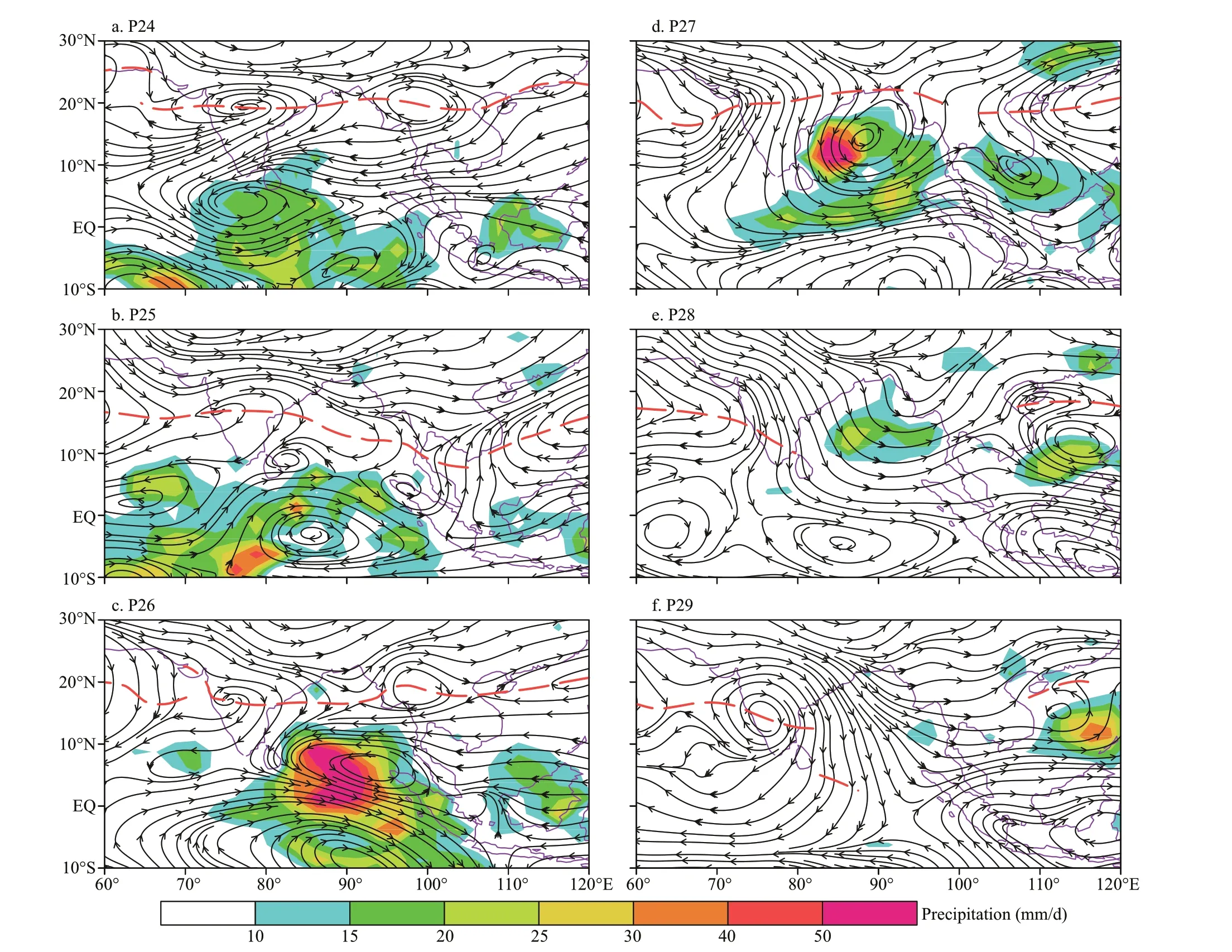
Fig.1 Pentad evolution of the 700-hPa wind (stream line) and precipitation (shading, unit: mm/d) during the lifespan of the MOV in 2003
Figure 4 displays the pentad evolution of the seawater temperature tendency averaged in the mixed layer to indicate the SST variation in the BOB. Prior to the formation of the BOB MOV, the SST tended to rise in the northern Indian ocean with its maximum in the BOB (Fig.4a & b), corresponding to the generation of the BOB spring warm pool. When the MOV formed in Pentad 26, the SST tendency began to decrease in the southern BOB, where the surface wind speed and sensible heat fl ux got enhanced (Fig.4c). As a result of the northward movement of the MOV, the cooling tendency of SST occurred in the northeastern BOB (Fig.4d), suggesting the weakening of the spring warm pool in the BOB. As the MOV gradually decayed in Pentad 28, the strong low-level northwesterly wind was evident over the BOB, followed by the continuous decrease tendency of the local SST (Fig.4e). This decrease tendency could persist until Pentad 29 when the BOB spring warm pool disappeared completely (Fig.4f). Since the BOB MOV could bring on large amount of rainfall, the barrier layer would come up due to the mass of fresh water input during the ASM onset. In the next section, we will show how the barrier layer modifi es the role of air-sea heat fl ux in the SST evolution during the onset of the BOBSM.

Fig.2 Same as Fig.1, but for the SST (shading, unit: °C)
3.2 Heat budget analysis
3.2.1 The net surface heat fl ux
Figure 5 shows the pentad evolution of the temperature tendency induced by the surface heat fl ux. Before the formation of the BOB MOV, the net surface heat fl ux could increase the SST in the northern Indian ocean. The warming center with a maximum greater than +0.4 K/pentad was positioned in the central and eastern BOB (Fig.5a & b), which was close to the center of the total SST tendency. It indicated that the formation of BOB spring warm pool was attributed primarily to the net surface heat fl ux. As the MOV formed over the southern BOB in Pentad 26, the SST tendency due to the net surface heat fl ux changed from positive to negative (Fig.5c), implying the loss of heat from the sea surface. In the developing stage of the MOV, the net surface heat fl ux was negative with its center over the central and eastern BOB (Fig.5d). Mass of heat lost from the upper ocean to the atmosphere via the air-sea interaction to decrease the local SST rapidly. The BOB spring warm pool began to attenuate in this stage. When the MOV weakened and disappeared in Pentad 28, the cooling center related to the net surface heat fl ux was confi ned to the northeastern BOB (Fig.5e) because of the strong low-level southwesterly wind. The SST thus further decreased to break the spring warm pool in the BOB. In Pentad 29, the southwesterly wind over the BOB was weakened to some extent (Fig.5f), corresponding to the disappearance of the cooling tendency associated with the net surface heat fl ux.
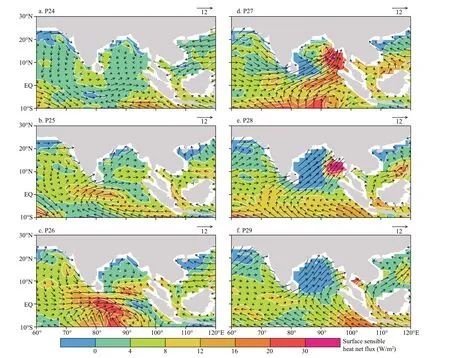
Fig.3 Same as Fig.1, but for the surface sensible heat net fl ux (shading, unit: W/m 2) and the 10-m wind (vector, unit: m/s)
To quantitatively evaluate the relative contribution of each component in the net surface heat fl ux to the SST tendency, Fig.6 presents the temporal evolution of these terms in the BOB (85°E–95°E, 5°N–15°N, shown in Fig.2a) during the lifespan of the MOV. Although some studies indicated that great uncertainties existed on the radiation fl ux between observation and diff erent reanalysis datasets (Wang et al., 2017; Zhang et al., 2018), the surface radiation fl ux from the NCEP/DOE was used to ensure the dynamic consistency among the datasets. Generally, the net surface heat fl ux depended on the downward solar radiation fl ux and the upward surface latent heat fl ux. In contrast, the contributions of the solar radiation penetrating the mixed layer (qd) and the surface longwave radiation fl ux were limited, and the eff ect of surface sensible heat fl ux was almost negligible. Before Pentad 26, the apparent low-level anticyclone over the BOB produced the tropospheric sinking and the clear-sky condition. Thus, strong solar radiation arrived at the sea surface (exceeding 250 W/m2). Meanwhile, the surface latent heat fl ux became weaker due to the small surface wind speed in situ. As the weak mixing eff ect in the upper ocean under the infl uences of small surface wind speed, a number of heating absorbed by the shallow mixed layer gave rise to the spring warm pool in the BOB. This favored the formation of the MOV and the onset of the BOBSM. However, theqdwas strong with its value over 50 W/m2and was quite close to the buoy observation (Sengupta et al., 2002). As a result, the heating eff ects of the net surface heat fl ux on the ML was reduced before the MOV formation.
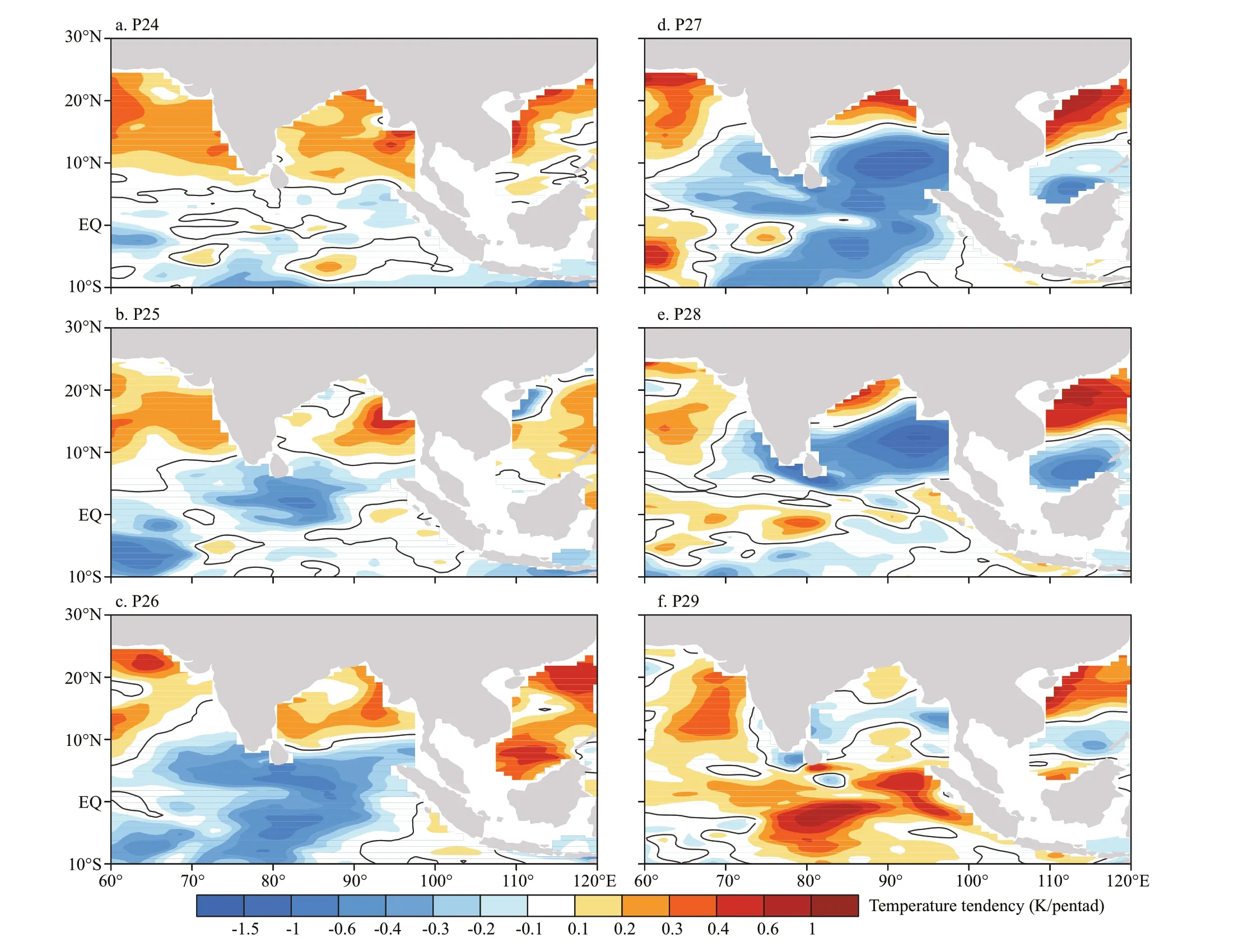
Fig.4 Same as Fig.1, but for the mixed layer seawater temperature tendency (unit: K/pentad)
When the MOV formed and developed in Pentads 26–27, more thicker clouds appeared over the BOB to remarkably reduce the net solar shortwave radiation (Qsw) and the net upward longwave radiation (Qlw), accompanied by the decrease of the solar radiation penetrating the MLD (qd). In the meantime, the enhanced surface southwesterly wind induced by the MOV could increase the upward surface latent heat fl ux (Qlw) rapidly via the wind-evaporation mechanism. Thus, mass of energy lost from ocean to atmosphere via the air-sea interface, presenting the negative-to-positive transition of the downward net surface heat fl ux over the BOB, where the SST was cooled evidently. As the MOV faded away in Pentad 28, the surface wind speed gradually weakened to attenuate the upward latent heat fl ux. The less transport of heat from ocean to atmosphere resulted in a weaker cooling tendency of SST over the BOB. Subsequently, the local net surface heat fl ux was below 50 W/m2in early June, when the solar radiation penetrating the MLD (qd) also gradually decreased to almost zero.
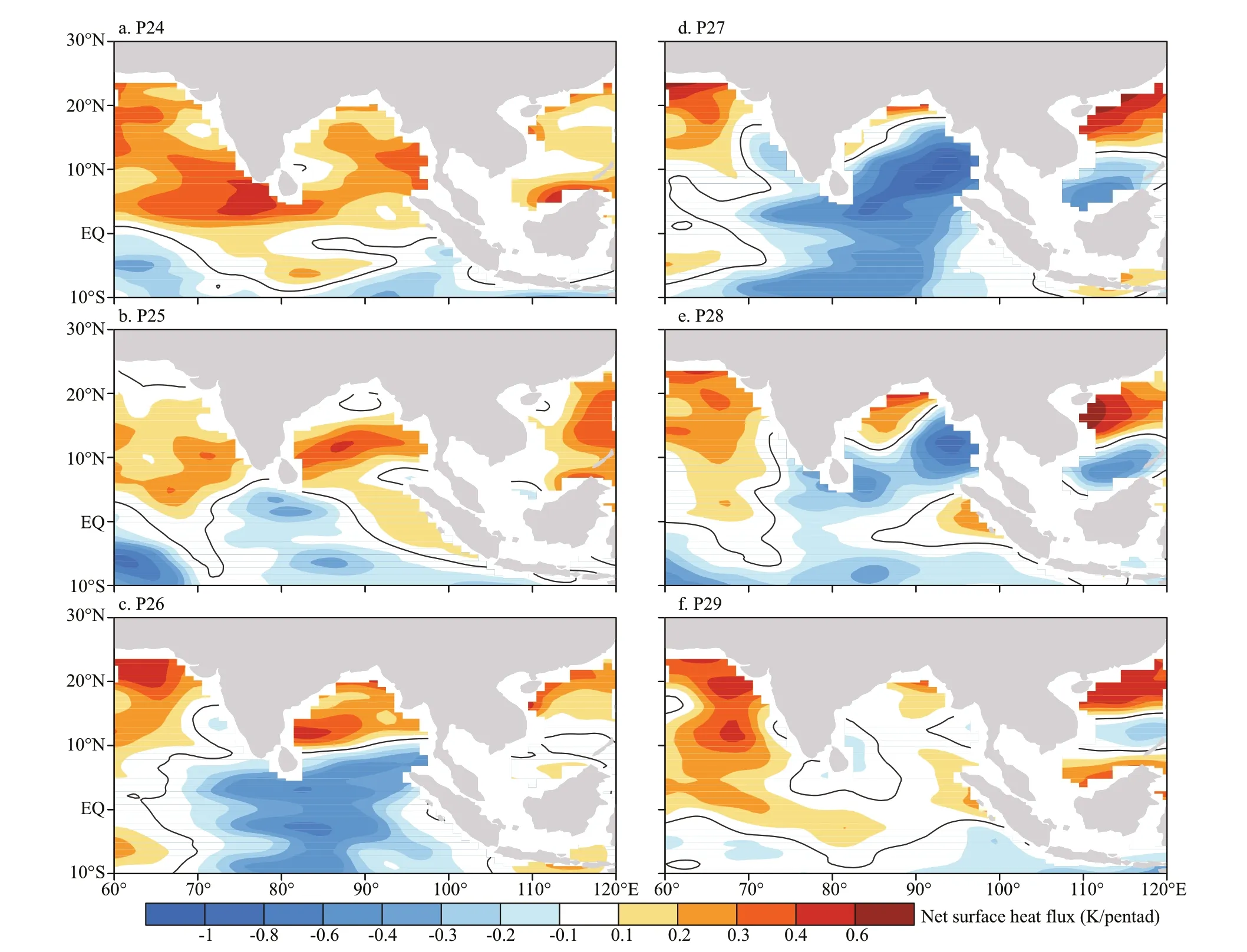
Fig.5 Same as Fig.4, but for the temperature tendency induced by the net surface heat fl ux (unit: K/pentad)
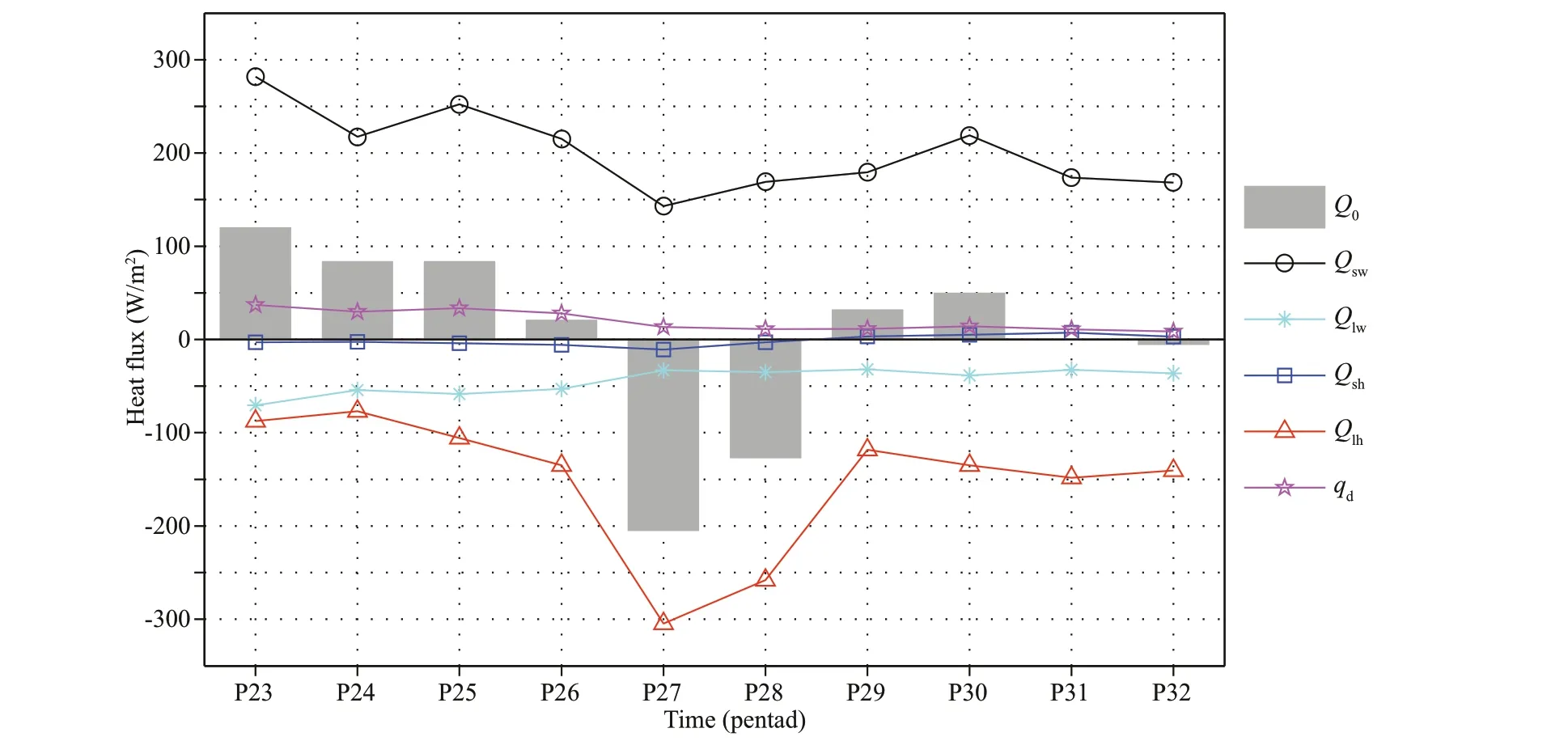
Fig.6 Pentad evolution of all the surface thermal forcing terms (unit: W/m 2) averaged in the BOB (85°E-95°E, 5°N-15°N) during the lifespan of the MOV
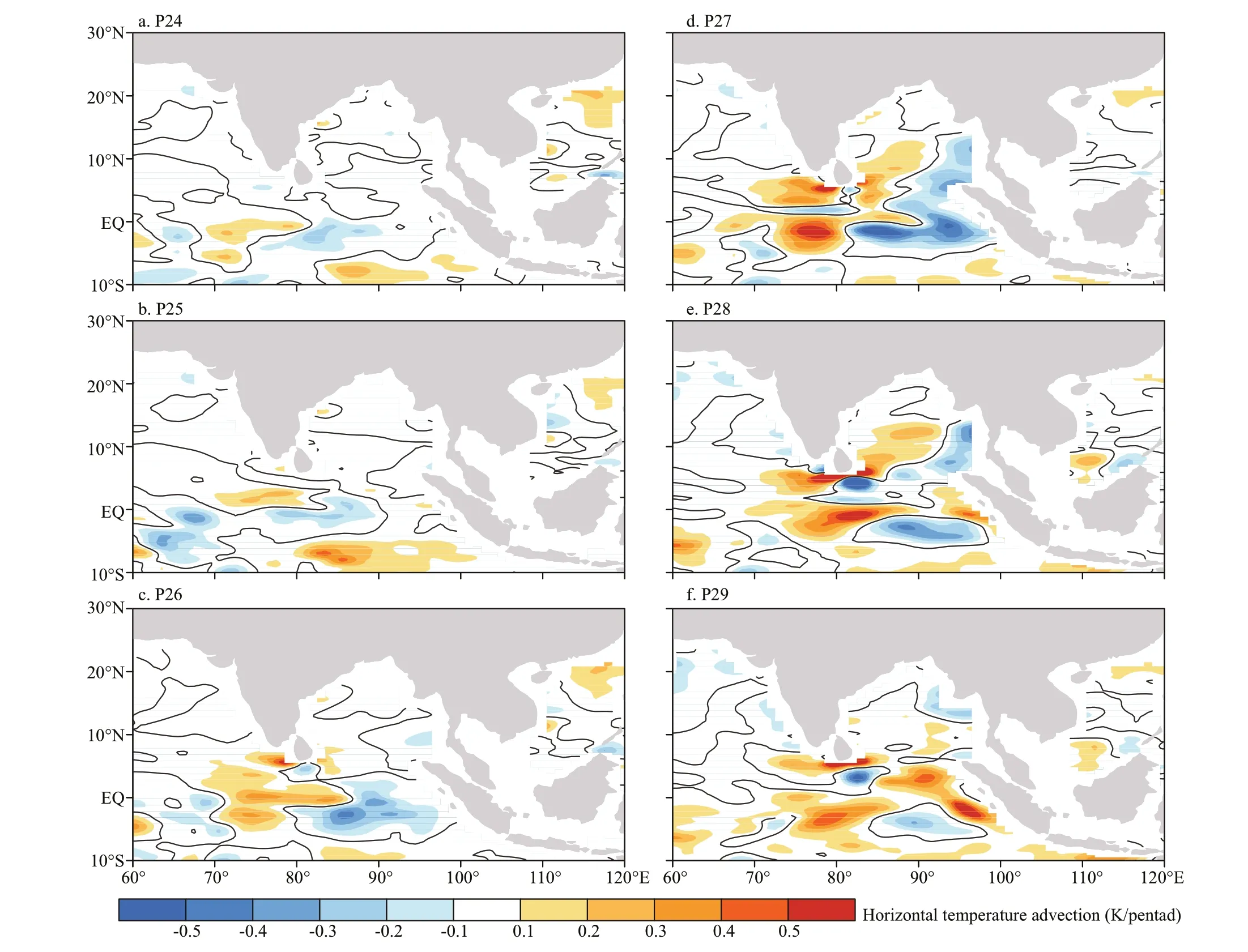
Fig.7 Same as Fig.4, but for the horizontal temperature advection in the mixed layer (unit: K/pentad)
Therefore, the evolution of the net surface heat fl ux during the formation and development of the MOV was primarily attributed to the changes of the downward solar radiation and the upward latent heat fl ux. Their joint eff ect caused the loss of upperoceanic heat to decrease SST in the BOB. The upward latent heat fl ux played a relatively more important role. In addition, the change of the solar radiation penetrating the MLD (qd) followed the variation of the downward solar radiation reaching the sea surface. Although the magnitude ofqdwas much smaller, suggesting its little contribution to the local SST after the generation of the MOV, we cannot ignore its eff ects on the formation of spring warm pool in the BOB before the formation of the MOV. Actually, theqdcould warm the seawater temperature below the mixed layer due to the shallower MLD, and then indirectly aff ected SST through the mixed layer process after the MOV formation. We will further investigate the role of the oceanic processes in the SST tendency over the BOB during the lifespan of the MOV.
3.2.2 Oceanic processes in the mixed layer
As shown by the Eq.1, the large-scale oceanic processes associated with the SST tendency included the horizontal advection of seawater temperature and the eff ect of vertical entrainment. Fig.7 depicted the temporal evolution of the SST tendency induced by the horizontal advection in the BOB. The horizontal advection was quite weak in the whole BOB region before the formation of the MOV (Fig.7a & b). Since the MOV formed over the southern BOB in Pentads 26–27, the horizontal temperature advection was strong in the southern but still weak in the northern BOB (Fig.7c & d). In Pentad 28 when the MOV began to decay, the positive center of horizontal temperature advection started to occur in the northern BOB (Fig.7e). The horizontal temperature advection in the mixed layer of the BOB completely vanished in Pentad 29 (Fig.7f). It was obviously noted that the warm and cold horizontal temperature advections were respectively found in the western and eastern of the southern BOB region in Pentads 27–28 (Fig.7d & e), which suggested the horizontal temperature advection was somehow important to the mixed layer temperature tendency. However, based on the results of the area averaged horizontal temperature advection, the total horizontal temperature advection in the mixed layer of the BOB contributed little to the SST cooling tendency during the formation and development processes of the MOV.
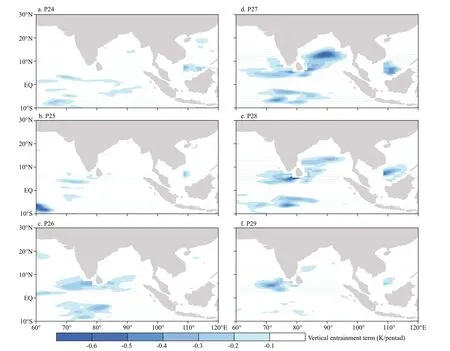
Fig.8 Same as Fig.4, but for the vertical entrainment term (unit: K/pentad)
Compared to the horizontal temperature advection in the mixed layer of the BOB, the upwelling of cold water caused by the vertical entrainment (Fig.8) played more important role in the SST tendency. Before the formation of the MOV, the oceanic mixing was relatively small due to the weak surface wind, along with little vertical entrainment in the northern Indian Ocean (Fig.8a & b). As the MOV formed over the southeastern BOB, the local surface wind was strengthened to increase the upper ocean mixing to the west of the MOV center, which enhanced the insitu vertical entrainment (Fig.8c). The SST thus decreased remarkably. With the northward movement of the MOV, the center of cooling due to vertical entrainment extended into the northern BOB in Pentad 27 (Fig.8d), resulting in a rapid decrease of the SST in the BOB. Since the northern BOB was controlled by the southwesterly wind over the northern BOB even after the MOV vanished, this cooling eff ect could still maintain in Pentad 28 (Fig.8e).
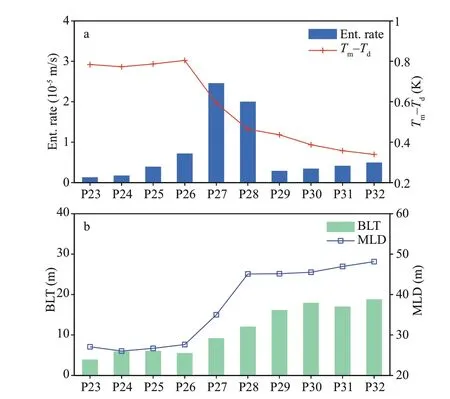
Fig.9 Pentad evolutions of the vertical entrainment rate and vertical temperature gradient (a), and MLD and BLT (b) in the BOB (85°E-95°E, 5°N-15°N) during the MOV lifespan from P23 to P32
Figure 9 provides more details about the vertical entrainment in the mixed layer of the BOB during the MOV lifespan. The entrainment rate depended on the vertical temperature gradient at the base of the mixed layer, the MLD and the BLT. Before Pentad 26, the upper ocean mixing in the BOB was rather weak due to the relatively small surface wind speed, corresponding to little entrainment in the mixed layer of the BOB (Fig.9a). Meanwhile, the average MLD in the BOB was quite shallow with its value of about 25 m (Fig.9b), but the vertical temperature gradient at the base of the mixed layer was quite large (Fig.9a). The thin mixed layer facilitated the penetrating of the solar radiation to the base of mixed layer where the barrier layer is thin in this stage (Fig.9b). When the MOV formed over the eastern BOB in Pentad 26, the local surface wind was strengthened rapidly (Fig.3c), leading to the stronger ocean mixing and the entrainment rate. Since the vertical temperature gradient changed little, the cold water was taken into the upper ocean by the entrainment at the base of the mixed layer. Afterwards, the intensifi ed ocean mixing could rapidly deepen the local MLD and enhance the entrainment rate in the upper ocean in Pentad 27, accompanied by the northward movement of the BOB MOV. The MOV-induced precipitation brought more freshwater into the BOB, where the salinity stratifi cation was changed to signifi cantly thicken the BLT. The vertical temperature gradient at the base of the mixed layer began to decrease remarkably (Fig.9a). As the MOV decayed over the northern BOB in Pentad 28, the strong surface southwesterly wind maintained the stirring and mixing in the upper ocean, followed by the continuous increase of the MLD to about 45 m (Fig.9b). On the other hand, the monsoonal precipitation could further stabilize the upper ocean salinity stratifi cation, causing that the BLT gradually increased to about 12 m, accompanied by the continuous decrease of the vertical temperature gradient (Fig.9). Thus, the upwelling of cold water was jointly attributed to both the vertical entrainment rate and the vertical temperature gradient at the base of the mixed layer during the development and decay phases of the BOB MOV.
With the enhancement of the surface wind and the monsoonal precipitation over the BOB, both the local MLD and BLT increased in the development and decay stages of the MOV. The stronger vertical entrainment was jointly induced by the deepened MLD and the enhanced upwelling motion at the base of the mixed layer, whereas the vertical temperature gradient at the base of the mixed layer was decreased due to the variations of theqdand the BLT. Prior to the formation of the MOV with shallow MLD in the BOB, the strongqdcould penetrate the mixed layer and directly heat the deeper water. When the MOV formed and moved onto the northern BOB, its resultant precipitation brought more fresh water into the BOB to change the salinity stratifi cation in situ, leading to a rapid increase of the BLT to 12–15 m. The vertical temperature gradient at the base of the mixed layer thus gradually decreased as the BLT increased. This result indicated that the thermal barrier eff ect of the BL could prevent the cooling eff ect of the upwelling cold water on the SST. On the other hand, the seawater below the mixed layer heated by theqdmight further rise the seawater temperature in the barrier layer, which enhanced the thermal barrier eff ect of the BL in advance. Therefore, the oceanic process associated with the changes ofqdand BLT could slow down the SST decrease after the formation of the BOB MOV to support the development of the MOV and the enhancement of the monsoonal convection.
Consequently, the changes of SST in the BOB were jointly modulated by the net surface heat fl ux and the upwelling of cold water during the lifespan of the MOV in 2003. Their relative contributions were quantitatively presented by Fig.10. Before the formation of the MOV in Pentad 26, the downward net surface heat fl ux could rise the SST to produce a spring warm pool in the BOB. At this moment, the oceanic process exhibited little impact on the SST changes. When the MOV formed over the eastern BOB in Pentad 26, the local SST started to decrease rapidly due to the upwelling of cold water induced by the stronger surface wind speed, along with little eff ects of the net surface heat fl ux. Whereas the atmospheric process became dominant in Pentad 27 and 28 when the MOV developed and moved northward. The evident reduction of the surface solar radiation and increase of the surface latent heat fl ux jointly produced the mass of heat loss from ocean to atmosphere, which rapidly decreased the SST in the BOB. In this episode, the cooling eff ects due to the oceanic process was weakened because of the thickening of BLT and the reduction of vertical temperature gradient at the base of the mixed layer, indicating the potential infl uences of barrier layer on slowing the SST decrease after the MOV formation. In addition, the horizontal ocean advection in the mixed layer always had little eff ect on the BOB SST change during the formation and development of the MOV.
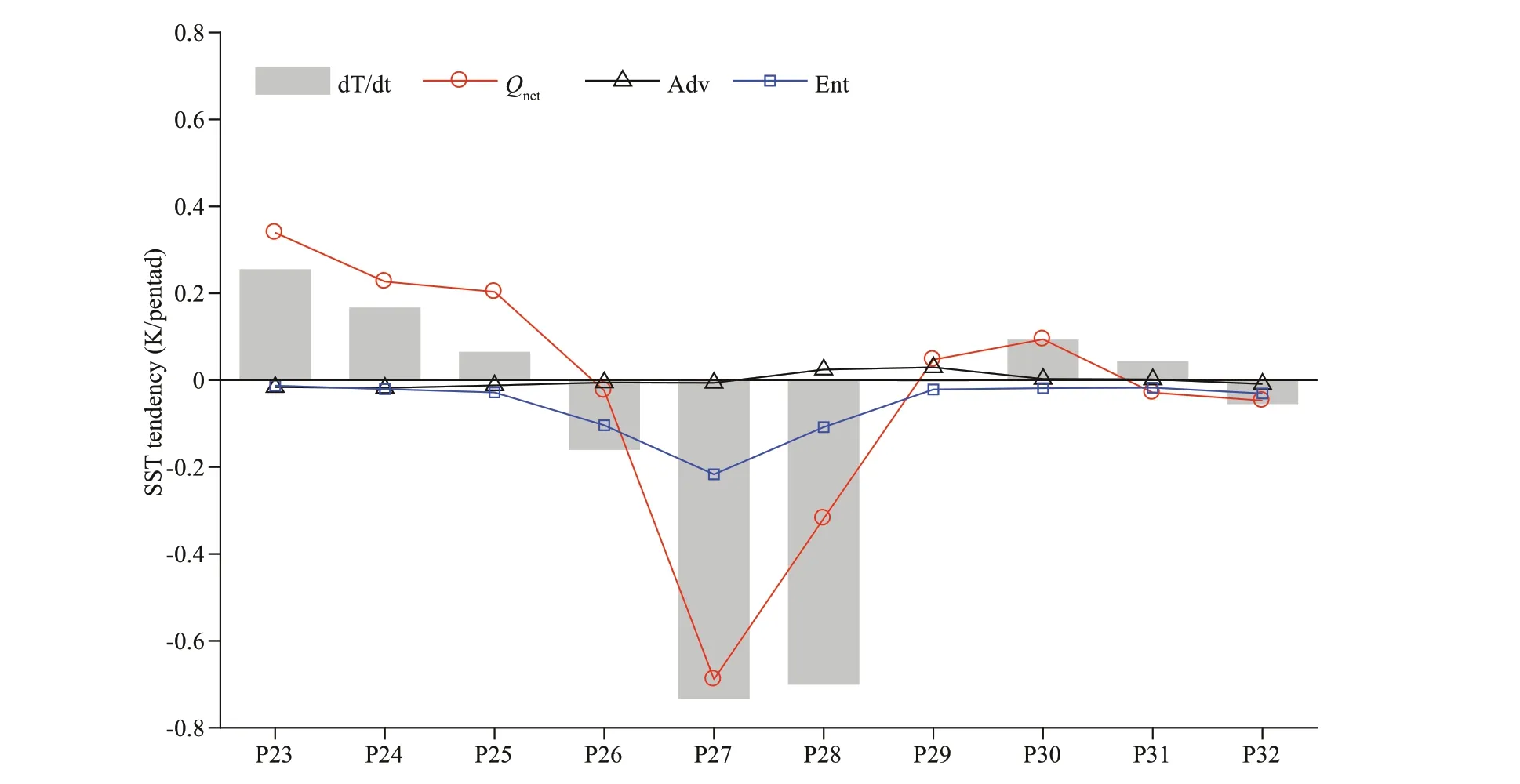
Fig.10 Relative contributions of atmospheric and oceanic process to the SST tendency (grey bars, unit: K/pentad) in the BOB (85°E-95°E, 5°N-15°N) during the MOV lifespan from P23 to P32
4 CONCLUSION
Based on the pentad mean NCEP GODAS reanalysis datasets, this study diagnosed the heat budget in the mixed layer of the BOB during the MOV lifespan from April to May 2003, and further investigated the potential infl uences of the solar radiation penetrating the MLD and the BLT on the evolution of spring warm pool. Figure 11 is a schematic diagram illustrating the major air-sea interaction process associated with the MOV. Before the formation of the MOV, the clear-sky condition induced by the anticyclone over the BOB led to mass of solar radiation reaching the sea surface. It could produce the BOB spring warm pool with shallow MLD in a short time. Part of solar radiation with about 50 W/m2could penetrate the shallow mixed layer and heat the deeper water. The direct eff ect of the solar radiation penetrating the MLD on the simultaneous SST was very weak, but it showed potential infl uences on the SST via the oceanic process after the MOV formation. When the MOV formed over the BOB in Pentad 26, the local surface wind speed strengthened rapidly, resulting in the stronger oceanic mixing and the deeper MLD. Therefore, the upwelling of cold water decreased the SST tendency evidently. During the development of the MOV with continuous strengthening surface southwesterlies, the net solar radiation reduced remarkably owing to the cloud-radiation eff ect, but the upward surface latent heat fl ux increased rapidly via the wind-evaporation mechanism. Thus, more energy lost from oceanic surface to atmosphere to further decrease SST in the BOB. In particular, the increased upward surface latent heat fl ux was the primary factor for the oceanic heat loss in this stage.
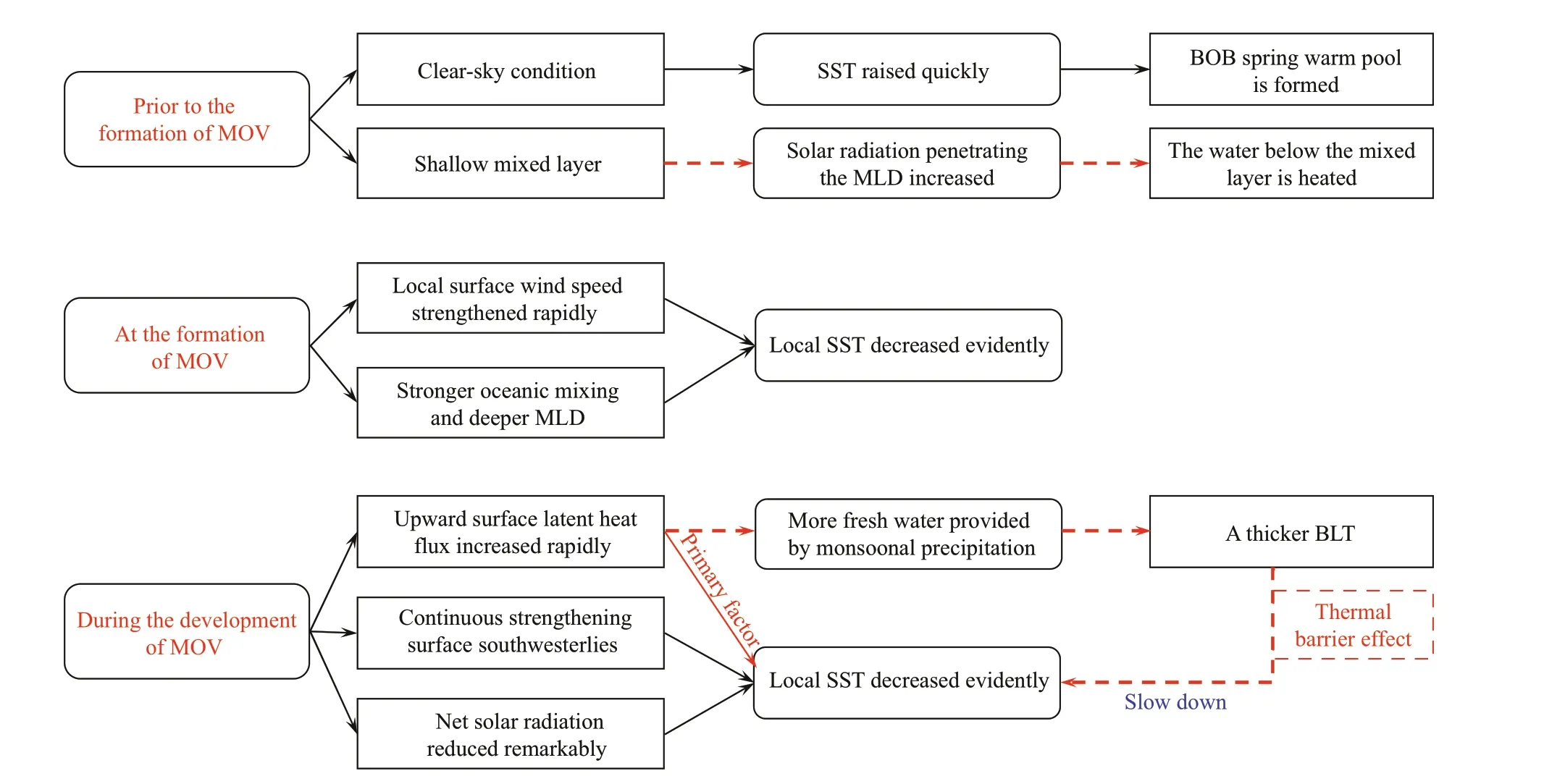
Fig.11 Schematic for the eff ects of MOV on the evolution of SST in the BOB
In the ocean, the cooling eff ect of entrainment upwelling was determined by the entrainment rate and the vertical temperature gradient at the base of the mixed layer. During the formation and development of the MOV, the entrainment rate increased rapidly along with the deepening of MLD, whereas the vertical temperature gradient at the base of the mixed layer decreased remarkably. This weaker vertical temperature gradient was attributable to the heating eff ect of the solar radiation penetrating the MLD and the thickening of BLT. On one hand, the solar radiations penetrating the MLD directly heat the water below the mixed layer before the formation of the MOV. On the other hand, as the MOV formed and developed, the monsoonal precipitation provided more fresh water into the BOB to change the salinity stratifi cation, resulting in a thicker BLT. The warmer seawater in the barrier layer could weaken the cooling eff ect of entrainment upwelling, which prolonged the life of spring warm pool in the BOB and facilitated the MOV development and the ASM onset. These results suggested that, besides the local air-sea interaction, other oceanic elements, such as the solar radiation fl ux penetrating the ML and the existence of barrier layer, might also play a role in modulating the eff ects of MOV on the evolution of SST in the BOB.
To ensure the dynamic consistency among the datasets, the surface radiation fl ux from the NCEP/DOE was used to emphasize the infl uences of the solar radiation penetrating the MLD and the BLT on the SST tendency during the MOV lifespan. However, recent studies indicated that great uncertainties existed on the radiation fl ux between observation and diff erent reanalysis datasets. Although the solar radiation penetrating the MLD estimated from the NCEP/DOE dataset was close to the result from the buoy observation, more reanalysis datasets might be needed to inspect the reliability of the solar radiation penetrating the MLD in the future work. In this study, we mainly focused on the infl uences of the air-sea heat fl ux and the cold water upwelling on the SST change, but did not considered other oceanic processes, such as the lateral diff usion and the mesoscale eddy, which might be the main source to the residual term. In addition, the variation of the BLT is controlled by the fresh water fl ux injecting into the upper ocean, however, the MOV-induced precipitation over the BOB exhibited large year-by-year diff erences. Therefore, more cases are needed to reveal the infl uences of the solar radiation penetrating the MLD and the BLT on the BOB SST changes on interannual timescale.
5 DATA AVAILABILITY STATEMENT
The datasets generated and/or analyzed during the current study are available from the corresponding author on reasonable request.
6 ACKNOWLEDGMENT
The authors gratefully acknowledge the use of the HPCC for all numeric simulations and data analysis at the South China Sea Institute of Oceanology, Chinese Academy of Sciences.
References
Behera S K, Deo A A, Salvekar P S. 1998. Investigation of mixed layer response to Bay of Bengal cyclone using a simple ocean model.Meteor.Atmos.Phys., 65(1-2): 77-91, https://doi.org/10.1007/BF01030270.
Behringer D W, Xue Y. 2004. Evaluation of the global ocean data assimilation system at NCEP: the Pacifi c Ocean.In: Proceedings of the 8th Symposium on Integrated Observing and Assimilation Systems for Atmosphere, Oceans, and Land Surface, AMS 84th Annual Meeting, Washington State Convention and Trade Center. Amer. Meteor. Soc., Seattle, WA.
Chen D K, Busalacchi A J, Rothstein L M. 1994. The roles of vertical mixing, solar radiation, and wind stress in a model simulation of the sea surface temperature seasonal cycle in the tropical Pacifi c Ocean.J.Geophys.Res., 99(C10): 20 345-20 359, https://doi.org/10.1029/94JC01621.
de Boyer Montégut C, Madec G, Fischer A S, Lazar A, Iudicone D. 2004. Mixed layer depth over the global ocean: an examination of profi le data and a profi le-based climatology.J.Geophys.Res., 109(C12): C12003, https://doi.org/10.1029/2004JC002378.
Du Y, Qu T D, Meyers G, Masumoto Y, Sasaki H. 2005. Seasonal heat budget in the mixed layer of the southeastern tropical Indian Ocean in a high-resolution ocean general circulation model.J.Geophys.Res., 110(4): C04012, https://doi.org/10.1029/2004JC002845.
Elsberry R L, Fraim T S, Trapnell Jr R N. 1976. A mixed layer model of the oceanic thermal response to hurricanes.J.Geophys.Res., 81(6): 1 153-1 162, https://doi.org/10.1029/JC081i006p01153.
Gadgil S, Kumar K R. 2006. The Asian monsoon-agriculture and economy.In: Wang B ed. The Asian Monsoon. Springer Praxis Books. Springer, Berlin, Heidelberg. p.651-683, https://doi.org/10.1007/3-540-37722-0_18.
Godfrey J S, Lindstrom E J. 1989. The heat budget of the equatorial western Pacifi c surface mixed layer.J.Geophys.Res., 94(C6): 8 007-8 017, https://doi.org/10. 1029/JC094iC06p08007.
He J H, Sun C H, Liu Y Y, Matsumoto J, Li W J. 2007. Seasonal transition features of large-scale moisture transport in the Asian-Australian monsoon region.Adv.Atmos.Sci., 24(1): 1-14, https://doi.org/10.1007/s00376-007-0001-5.
He J H, Wen M, Wang L J, Xu H M. 2006. Characteristics of the onset of the Asian summer monsoon and the importance of Asian-Australian “land bridge”.Adv.Atmos.Sci., 23(6): 951-963, https://doi.org/10.1007/s00376-006-0951-z.
Kanamitsu M, Ebisuzaki W, Woollen J, Yang S K, Hnilo J J, Fiorino M, Potter G L. 2002. NCEP-DOE AMIP-II reanalysis (R-2).Bull.Amer.Meteor.Soc., 83(11): 1 631-1 644, http://doi.org/10.1175/BAMS-83-11-1631.
Kara A B, Rochford P A, Hurlburt H E. 2000a. Mixed layer depth variability and barrier layer formation over the North Pacifi c Ocean.J.Geophys.Res., 105(C7): 16 783-16 801, http://doi.org/10.1029/2000JC900071.
Kara A B, Rochford P A, Hurlburt H E. 2000b. An optimal defi nition for ocean mixed layer depth.J.Geophys.Res., 105(C7): 16 803-16 821, http://doi.org/10.1029/ 2000JC900072.
Kraus E B, Turner J S. 1967. A one-dimensional model of the seasonal thermocline II. The general theory and its consequences.Tellus, 19(1): 98-106, https://doi.org/10. 1111/j.2153-3490.1967.tb01462.x.
Lau K M, Wu H T, Yang S. 1998. Hydrologic processes associated with the fi rst transition of the Asian summer monsoon: a pilot satellite Study.Bull.Amer.Meteor.Soc., 79(9): 1 871-1 882, https://doi.org/10.1175/1520-0477 (1998)079<1871:HPAWTF>2.0.CO;2.
Lewis M R, Carr M E, Feldman G C, Esaias W, McClain C. 1990. Infl uence of penetrating solar radiation on the heat budget of the equatorial Pacifi c Ocean.Nature, 347(6293): 543-545, https://doi.org/10.1038/347543a0.
Liu B Q, Liu Y M, Wu G X, Yan J H, He J H, Ren S L. 2015. Asian summer monsoon onset barrier and its formation mechanism.ClimateDyn., 45(3-4): 711-726, https://doi.org/10.1007/s00382-014-2296-0.
Liu B Q, Wu G X, Mao J Y, He J H. 2013. Genesis of the South Asian High and its impact on the Asian summer monsoon onset.J.Climate, 26(9): 2 976-2 991. http://doi.org./10. 1175/JCLI-D-12-00286.1.
Liu Y M, Chan J C L, Mao J Y, Wu G X. 2002. The role of Bay of Bengal convection in the onset of the 1998 South China Sea summer monsoon.Mon.Wea.Rev., 130(11): 2 731-2 744, https://doi.org/10.1175/1520-0493(2002)130< 2731:TROBOB>2.0.CO;2.
Lukas R, Lindstrom E. 1991. The mixed layer of the western equatorial Pacifi c Ocean.J.Geophys.Res., 96(S01): 3 343-3 357, https://doi.org/10.1029/90JC01951.
Mao J Y, Wu G X. 2011. Barotropic process contributing to the formation and growth of tropical cyclone Nargis.Adv.Atmos.Sci., 28(3): 483-491, https://doi.org/10.1007/s00376-010-9190-4.
Mao J, Wu G. 2007. Interannual variability in the onset of the summer monsoon over the Eastern Bay of Bengal.Theor.Appl.Climatol., 89(3-4): 155-170, https://doi.org/10.1007/s00704-006-0265-1.
McPhaden M J, Foltz G R, Lee T, Murty V S N, Ravichandran M, Vecchi G A, Vialard J, Wiggert J D, Yu L S. 2009. Ocean-atmosphere interactions during cyclone Nargis.Eos,TransactionsAmericanGeophysicalUnion, 90(7): 53-54, https://doi.org/10.1029/2009EO070001.
Ohlmann J C, Siegel D A, Gautier C. 1996. Ocean mixed layer radiant heating and solar penetration: a global analysis.J.Climate, 9(10): 2 265-2 280, https://doi.org/10.1175/1520-0442(1996)009<2265:OMLRHA>2.0.CO;2.
Pacanowski R C, Griffi es S M. 1999. The MOM3 Manual. NOAA/Geophysical Fluid Dynamics Laboratory Technical Report No. 4, NOAA/Geophysical Fluid Dynamics Laboratory, Princeton, USA, 680p.
Prasanna Kumar S, Narvekar J. 2005. Seasonal variability of the mixed layer in the central Arabian Sea and its implication on nutrients and primary productivity.DeepSeaRes.II, 52(14-15): 1 848-1 861, https://doi.org/10. 1016/j.dsr2.2005.06.002.
Price J F. 1981. Upper ocean response to a hurricane.J.Phys.Oceanogr., 11(2): 153-175, https://doi.org/10.1175/1520-0485(1981)011<0153:UORTAH>2.0.CO;2.
Qiu B. 2000. Interannual variability of the kuroshio extension system and its impact on the wintertime SST fi eld.J.Phys.Oceanogr., 30(6): 1 486-1 502, http://doi.org/10. 1175/1520-0485(2000)030<1486:IVOTKE>2.0.CO;2.
Qu T D. 2003. Mixed layer heat balance in the western North Pacifi c.J.Geophys.Res., 108(C7): 3 242, https://doi.org/10.1029/2002JC001536.
Reynolds R W, Rayner N A, Smith T M, Stokes D C, Wang W Q. 2002. An improved in situ and Satellite SST analysis for climate.J.Climate, 15(13): 1 609-1 625, https://doi.org/ 10.1175/1520-0442(2002)015<1609:AIISAS>2.0.CO;2.
Saha S, Nadiga S, Thiaw C, Wang J, Wang W, Zhang Q, Van den Dool H M, Pan H L, Moorthi S, Behringer D, Stokes D, Peña M, Lord S, White G, Ebisuzaki W, Peng P, Xie P. 2006. The NCEP climate forecast system.J.Climate, 19(15): 3 483-3 517, https://doi.org/10.1175/JCLI3812.1.
Sakaida F, Kawamura H, Toba Y. 1998. Sea surface cooling caused by typhoons in the Tohoku area in August 1989.J.Geophys.Res., 103(C1): 1 053-1 065, https://doi.org/10. 1029/97JC01859.
Santoso A, Sen Gupta A, England M H. 2010. Genesis of Indian ocean mixed layer temperature anomalies: a heat budget analysis.J.Climate, 23(20): 5 375-5 403, https://doi.org/10.1175/2010JCLI3072.1.
Sengupta D, Ray P K, Bhat G S. 2002. Spring warming of the eastern Arabian sea and Bay of Bengal from Buoy data.Geophys.Res.Lett., 29(15): 1 734, http://doi.org/10. 1029/2002GL015340.
Shi Y Y, Huang W Y, Wang B, Yang Z F, He X S, Qiu T P. 2018. Origin of warm SST bias over the Atlantic cold tongue in the coupled climate model FGOALS-g2.Atmosphere, 9(7): 275, https://doi.org/10.3390/atmos9070275.
Shi Y Y, Wang B, Huang W Y. 2017. A ‘self-adjustment’ mechanism for mixed-layer heat budget in the equatorial Atlantic cold tongue.Atmos.Sci.Lett., 18(2): 82-87, https://doi.org/10.1002/asl.728.
Sprintall J, Tomczak M. 1992. Evidence of the barrier layer in the surface layer of the tropics.J.Geophys.Res., 97(C5): 7 305-7 316, http://doi.org/10.1029/92JC00407.
Sutton P J, Worcester P F, Masters G, Cornuelle B D, Lynch J F. 1993. Ocean mixed layers and acoustic pulse propagation in the Greenland Sea.J.AcousticalSoc.Amer., 94(3): 1 517-1 526, https://doi.org/10.1121/1.408128.
Swenson M S, Hansen D V. 1999. Tropical Pacifi c Ocean mixed layer heat budget: the Pacifi c cold tongue.J.Phys.Oceanogr., 29(1): 69-81, https://doi.org/10.1175/1520-0485(1999)029<0069:TPOMLH>2.0.CO;2.
Trenberth K E, Hurrell J W, Stepaniak D P. 2006. The Asian monsoon: global perspectives.In: Wang B ed. The Asian Monsoon. Springer, Berlin, Heidelberg. p.67-87, https://doi.org/10.1007/3-540-37722-0_2.
Vinayachandran P N, Shankar D, Kurian J, Durand F, Shenoi S S C. 2007. Arabian Sea mini warm pool and the monsoon onset vortex.Curr.Sci., 93(2): 203-214.
Wang B, Lin H. 2002. Rainy season of the Asian-Pacifi c summer monsoon.J.Climate, 15(4): 386-398, https://doi.org/10.1175/1520-0442(2002)015<0386:RSOTAP>2.0.CO;2.
Wang B, Wu R G, Lau K M. 2001. Interannual variability of the Asian summer monsoon: contrasts between the Indian and the western North Pacifi c-East Asian monsoons.J.Climate, 14(20): 4 073-4 090, https://doi.org/10.1175/ 1520-0442(2001)014<4073:IVOTAS>2.0.CO;2.
Wang X, Zhang R W, Huang J, Zeng L L, Huang F. 2017. Biases of fi ve latent heat fl ux products and their impacts on mixed-layer temperature estimates in the South China Sea.J.Geophys.Res., 122(6): 5 088-5 104, https://doi.org/10.1002/2016JC012332.
Wang Z Q, Li G, Yang S. 2018. Origin of Indian summer monsoon rainfall biases in CMIP5 multimodel ensemble.ClimateDyn., 51(1-2): 755-768, https://doi.org/10.1007/s00382-017-3953-x.
Wu G X, Guan Y, Liu Y M, Yan J H, Mao J Y. 2012. Air–sea interaction and formation of the Asian summer monsoon onset vortex over the Bay of Bengal.ClimateDyn., 38(1-2): 261-279, https://doi.org/10.1007/s00382-010-0978-9.
Wu G X, Guan Y, Wang T M, Liu Y M, Yan J H, Mao J Y. 2011. Vortex genesis over the Bay of Bengal in spring and its role in the onset of the Asian Summer Monsoon.Sci.ChinaEarthSci., 54(1): 1-9, https://doi.org/10.1007/s11430-010-4125-6.
Wu G X, Liu Y M. 2000. Thermal adaptation, overshooting, dispersion, and subtropical anticyclone Part I: thermal adaptation and Overshooting.Chin.J.Atmos.Sci., 24(4): 433-446. (in Chinese with English abstract)
Wu G X, Zhang Y S. 1998. Tibetan Plateau forcing and the timing of the monsoon onset over South Asia and the South China Sea.Mon.Wea.Rev., 126(4): 913-927, https://doi.org/10.1175/1520-0493(1998)126<0913:TPFA TT>2.0.CO;2.
Xie P P, Arkin P A. 1997. Global precipitation: a 17-year monthly analysis based on gauge observations, satellite estimates, and numerical model outputs.Bull.Amer.Meteor.Soc., 78(11): 2 539-2 558. http://doi.org/10. 1175/1520-0477(1997)078<2539:gpayma>2.0.co;2.
You Y Z. 1995. Salinity variability and its role in the barrier-layer formation during TOGA-COARE.J.Phys.Oceanogr., 25(11): 2 778-2 807, http://doi.org/10.1175/1520-0485(1995)025<2778:SVAIRI>2.0.CO;2.
Zeng Z H, Chen L T. 2011. Numerical experiments of the eff ect of oceanic mixing layer depth on TC structure and intensity changes.PlateauMeteor., 30(6): 1 584-1 593. (in Chinese with English abstract)
Zhang R W, Wang X, Wang C Z. 2018. On the simulations of global oceanic latent heat fl ux in the CMIP5 multimodel ensemble.J.Climate, 31(17): 7 111-7 128, https://doi.org/10.1175/jcli-d-17-0713.1.
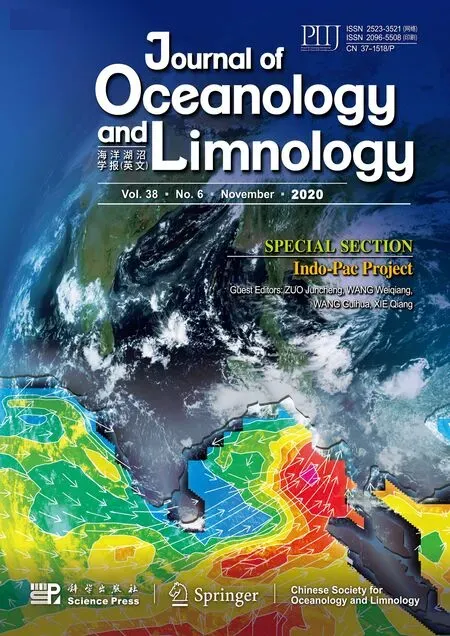 Journal of Oceanology and Limnology2020年6期
Journal of Oceanology and Limnology2020年6期
- Journal of Oceanology and Limnology的其它文章
- Eff ects of vitamin C defi ciency or excess on growth performance, anti-oxidative response and fatty acid composition of juvenile abalone Haliotis discu s hannai Ino*
- Exploring sensitive area in the tropical Indian Ocean for El Niño prediction: implication for targeted observation*
- Analysis of the typhoon wave distribution simulated in WAVEWATCH-III model in the context of Kuroshio and wind-induced current*
- Characterizing the capability of mesoscale eddies to carry drifters in the northwest Pacifi c*
- Observation system simulation experiments using an ensemble-based method in the northeastern South China Sea*
- Statistical analysis of intensity variations in tropical cyclones in the East China Sea passing over the Kuroshio*
